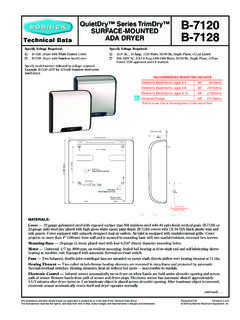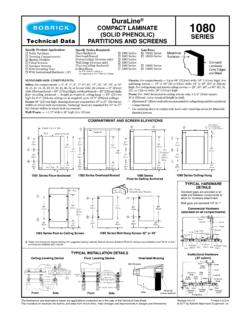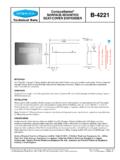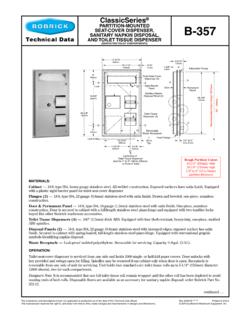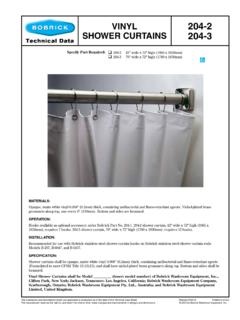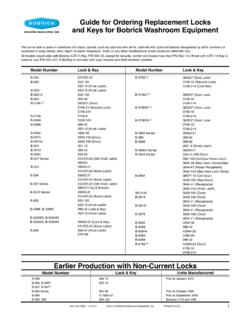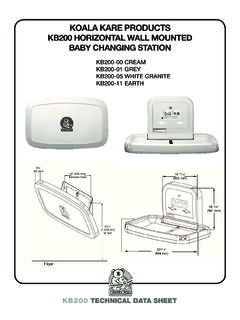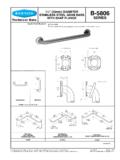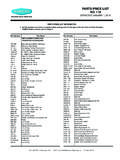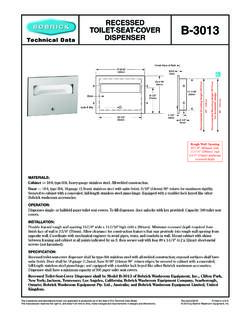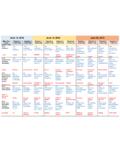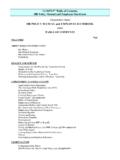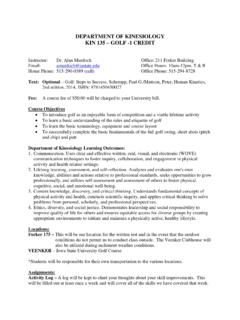Transcription of Planning guide for accessible restroo ms - Bobrick …
1 0. 25. Planning guide for accessible Restrooms 60 min 48 1525. 122 Wheelch 0. t urning air sp ace 48 t 1220. 30 x 48. 760 x 1. Clear flo 2 20. or sp ace Baby ch an 19 x 33 ging st at ion inches (. in down 4. posit ion 85 x 840mm). 30 x 48. 760 x 1. 2. Clear flo 20. or sp at lavat ace or y Ver t ical gr 56 x 6 0 (455mm ab bar s 18 inc ) long ( he 1420 x min ICC/A N s W hee 1525 SI). lch toilet co air accessible 30 x 48. mpa wall -mo r t ment wit h 760 x 1. 2. Clear flo 20. unt e d t o or sp a ilet at urina ce 56 x 6 0. l 1420 x min Urinal w Whee 1525. elongat it h lch toilet co air accessib e d b owl mpa wall -mo r t ment wi unt e d t o ilet Referencing: 2010 ADA Standards for accessible Design ICC - 2009 accessible And Usable Buildings And Facilities INTRODUCTION into or referred to by local/state building codes, the 2009 ICC/ANSI Standard's dimensions are also shown where they deviate or where complying with the 2010 ADA Standards would The Americans with Disabilities Act (ADA) set the minimum requirements both scoping not accomplish the same outcome.
2 When working on projects with both ANSI and ADA. and technical for newly designed and constructed or altered state and local government jurisdiction, the more stringent of the two standards should be followed. While substantially facilities, public accommodations, and commercial facilities to be readily accessible to similar for restrooms, we have noted throughout the document where differences occur. For and usable by individuals with disabilities. This means in restroom design some of each purposes of simplicity and readability, we refer primarily to the 2010 ADA Standards in the type of fixture or feature as well as the installation location must meet accessibility text and in the Figures. requirements contained in the 2010 ADA Standards for accessible Design.
3 In addition, Accessibility standards contain many prescriptive dimensional or scoping requirements many projects must also follow the provisions of the 2009 revision of ICC , that are legal, design, or construction minimums. Where requirements allow, it is good accessible and Usable Buildings and Facilities (produced by the American National practice to avoid designing and building to the minimums of the dimensional specifications in Standards Institute or ANSI). accessibility standards. Doing so places the design, construction and ownership team at risk The information contained herein is of an advisory nature only and represents Bobrick of non-compliance. In general, accessibility tolerances can be much narrower than tolerances Washroom Equipment, Inc.
4 's interpretation of the 2010 ADA Standards for accessible Design found in common practice. (We recommend a thorough review of the 2010 ADA Standards: (referred to as, 2010 ADA Standards) and the ICC , accessible and Usable Buildings Construction and Manufacturing Tolerances and the related Advisory). Note that some and Facilities (referred to as 2009 ICC/ANSI Standards). Use of this document is not a items are listed as absolutes, and other dimensions are listed as ranges. For example, if 1- . substitute for the study and understanding of the two accessibility standards that are inches was an absolute requirement, avoid specifying 1- inches plus or minus X inches. referenced. In addition, all building plans should be reviewed by local jurisdictions to ensure compliance.
5 This Planning guide does not refer to the International Plumbing Code, the International Residential Code, International Building Code, or any other model code or state ACCOMMODATING. building code. Differences may be present and need to be thoroughly researched. DIVERSE USERS. Bobrick has prepared this Planning guide for use by planners, architects, designers, Public restrooms are one of the most critical building amenities because they need to be specifiers, building owners and facilities/property managers. In addition, Bobrick 's responsive to a wide range of human needs and abilities. Architectural Representatives are available to assist with the application of appropriate The needs of a person using a wheelchair and the space the wheelchairs require product specifications and installation criteria.
6 Are used as a primary source of design information for accessible restrooms in terms of amount of space and paths of travel. The fixed nature of the equipment imposes finite ACCESSIBILITY STANDARDS space requirements and limits reach ranges of users. The number of individuals who use wheelchairs has grown considerably in recent years, as has the variety of wheelchair types The Americans with Disabilities Act (ADA) is a federal civil rights law that prohibits and sizes. The trend has been dwarfed by the growth in the number and variety of people discrimination against people with disabilities by ensuring equal access to goods and who use scooters, which have different sizes and use parameters. Scooters can be larger services. It recognizes inaccessible facilities as a form of discrimination, since these facilities and need even more space to maneuver.
7 The accessibility standards have not reflected these can prohibit participation by people with disabilities. The regulations for implementing the trends. Designers should provide extra space that mobility equipment devices require, and ADA include both scoping and technical specifications for new or altered State and local not rely on minimum standards. government facilities, public accommodations and commercial facilities to be accessible to The 2010 ADA Standards require the provision of ambulatory accessible toilet and usable by individuals with disabilities. Originally known as ADA Accessibility Guidelines compartments to support the needs of individuals who are ambulatory and may require for Buildings and Facilities (ADAAG) in 1991, the 2010 ADA Standards are the latest in a the use of a cane, walker or crutches.
8 Mounting locations and the proximity of equipment series of Guidelines and Standards that have been issued by the United States Access Board are important for people who use wheelchairs and who may have limited reach range. The (the Access Board) and adopted by the Department of Justice to enforce the ADA. The law design standards reflect these users' needs in the mounting heights for common accessories, applies to most buildings and facility types nationwide regardless of state or local code such as mirrors, paper towel dispensers, waste receptacles, soap dispensers, napkin/tampon requirements, but it is not a building code. Facilities that are newly constructed or altered on vendors, and toilet partition-mounted equipment, including grab bars, toilet tissue, and seat- or after March 15, 2012 must comply with the 2010 ADA Standards.
9 Cover dispensers, and sanitary napkin disposals. Authority has been left with each state and local government to adopt and enforce its While the 2010 ADA Standards are principally intended to benefit people with own building codes, but the office of the Assistant Attorney General for Civil Rights has disabilities, experience has shown that environments built with accessible and universal the authority under the ADA to certify that a state or local building code meets or exceeds design features often benefit a wide range of users, including: the minimum requirements of ADA, and such certification of equivalency can be used as rebuttable evidence in any subsequent litigation. For public accommodations and commercial People with stability and balance issues facilities, the ADA Standards, or a state or local building code that has been certified as Children and people who are short or tall equivalent to the ADA Standards by the Assistant Attorney General, must be used.
10 People who are large or heavy Nothing in the 2010 ADA Standard requirements prevents the use of designs, products, People with temporary health problems, such as broken bones or those who are or technologies as alternatives to those prescribed, provided they result in substantially recovering from surgery equivalent or greater accessibility and usability. This is referred to as equivalent facilitation and is the covered entities' responsibility to demonstrate equivalent facilitation in the Older people event of a challenge. It is also important to note there is no process for certifying that an Individuals who need assistance with their restroom activities alternative design provides equivalent facilitation. Parents attending to their children using strollers and baby changing activities.
